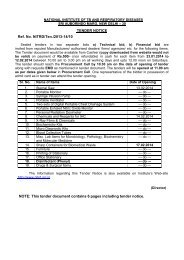October - LRS Institute of Tuberculosis & Respiratory Diseases
October - LRS Institute of Tuberculosis & Respiratory Diseases
October - LRS Institute of Tuberculosis & Respiratory Diseases
You also want an ePaper? Increase the reach of your titles
YUMPU automatically turns print PDFs into web optimized ePapers that Google loves.
REVIEW ARTICLE Ind. J. Tub., 1986, 33, 167<br />
PATHOGENESIS OF COR RCILMONALE IN PULMONARY TUBERCULOSIS<br />
S. C. KAPOOR<br />
Summary : A study <strong>of</strong> the relevant literature on Chronic Cor Pulmonale (CCP) as a<br />
complication <strong>of</strong> Pulmonary <strong>Tuberculosis</strong> reveals that this complication, infrequent in<br />
the pre-chemotherapy era, is now encountered frequently in treated patients. The<br />
literature on pathogenesis <strong>of</strong> Chronic Cor Pulmonale has been critically reviewed and<br />
it has been concluded that repeated secondary infections in residual bronchial<br />
distortions, cavities and other fibrotic healed lesions play a decisive role in the<br />
development <strong>of</strong> this condition. A short note on the clinical application <strong>of</strong> the pathology<br />
<strong>of</strong> healing has also been included.<br />
Introduction<br />
Although it was recognised even as far<br />
back as the 19th century that myocardial<br />
damage can be found on autopsy in patients<br />
dying <strong>of</strong> pulmonary tuberculosis, clinically<br />
diagnosable Cor pulmonale was rarely seen<br />
as a complication <strong>of</strong> chronic Pulmonary<br />
<strong>Tuberculosis</strong>.<br />
Huriez (1934) and Brumfiel (1933,<br />
1943) have described circulatory disorders<br />
in cases <strong>of</strong> Pulmonary <strong>Tuberculosis</strong>, but<br />
without CCF.There have been few reports<br />
about the occurrence <strong>of</strong> CCF in such cases<br />
in the prechemotherapy era. Nemet and<br />
Rosenblatt (1937) saw RightVentricular<br />
hypertrophy (RVH) in 33 <strong>of</strong> 71 autopsies in<br />
patients dying <strong>of</strong> pulmonary tuberculosis,<br />
but the heart, significantly, did not show<br />
increase in weight. The clinical features<br />
were dyspnoea in 91%, cyanosis 70%, neck<br />
vein engorgement 33%, hepatomegaly 42%<br />
and moderate leg odema in 45Y., but no<br />
ascites, They could not clinically label even<br />
one third <strong>of</strong> these cases as having cardiac<br />
involvement. as alternative explanations<br />
were possible. White (1947) has stated that<br />
it is rare to see any deleterious effect <strong>of</strong><br />
extensive tuberculosis on the heart and<br />
even less common to get right ventricular<br />
failure. As late as 1951, Bjorkman reported<br />
only 7 patients with moderate Right heart<br />
strain pattern and one with a definite P<br />
pulmonale in serial ECGs on 476 patients<br />
<strong>of</strong> pulmonary tuberculosis. Even cardiac<br />
catheterisation did not reveal any<br />
significant pulmonary hypertension, and<br />
pathological studies by Berblinger (1947),<br />
and by Higgins (1944), did not reveal any<br />
significant pulmonary vascular disease,<br />
although they did find RVH in 56% and<br />
40% <strong>of</strong> their autopsies, respectively.<br />
After the advent <strong>of</strong> chemotherapy,<br />
however, Cor pulmonale began, slowly, to<br />
be recognised as a complication in the living<br />
patients <strong>of</strong><br />
CorrespondenceAddress:<br />
Dr. S.C. Kapoor, House No. 12-5-17/1/1,<br />
Bathkhamakunta, Secunderabad- 500017<br />
pulmonary tuberculosis. Even in the early<br />
era it had been mentioned as occurring,<br />
although rarely, in tuberculosis patients<br />
who had undergone extensive<br />
thoracoplastly etc. However, the first<br />
authentic report in a clinical series was by<br />
Samuelson (1952) who found that 45 <strong>of</strong> his<br />
patients had this complication. Walzer and<br />
Frost (1954) reported an autopsy series in<br />
which 60 % <strong>of</strong> cases <strong>of</strong> Cor pulmonale were<br />
ascribed to pulmonary tuberculosis, and 51<br />
% <strong>of</strong> pulmonary tuberculosis cases had<br />
RVH, while Kozlowski and Maldyke (1955)<br />
had full-fledged Cor pulmonale in only 10<br />
<strong>of</strong> their autopsies on such subjects, against<br />
81 % histological cardiac damage. Corbetta,<br />
Pozzi and Scoccia (1955) concluded that<br />
early stages <strong>of</strong> Cor pulmonale were very<br />
common in Pulmonary tuberculosis, finding<br />
diagnostic ECG change in 43 % 0 <strong>of</strong> their<br />
patients. In this country also, Cor<br />
pulmonale had rarely been diagnosed in<br />
cases <strong>of</strong> pul. tuberculosis as can be seen<br />
from the reports by Malhotra (1962) and<br />
Padmavathi and Pathak (1959). However a<br />
<strong>Tuberculosis</strong> Hospital reported the presence<br />
<strong>of</strong> this complication in 1959 (Kapoor 1959)<br />
and a series <strong>of</strong> 200 cases was reported in<br />
1962 (Kapoor 1962). This complication was<br />
seen to occur in 17 <strong>of</strong> 100 patients <strong>of</strong> pul.<br />
tuberculosis lying in hospital wards on a<br />
single day. Subsequently, Padmavathi and<br />
Mishra (1969) reported tubercular aetiology<br />
in 32 out <strong>of</strong> 454 cases <strong>of</strong> Cor pulmonale (7<br />
Y.). Vishwanathan (1969) had similar<br />
findings. However, studies carried out<br />
among tuberculosis patients again revealed<br />
a heavy incidence <strong>of</strong> Cor pulmonale, e.g.,<br />
15.8% by Agarwal et al. (1978) or even<br />
47.5% by Chatterjee et al. (1971). We had<br />
reported on 51 cases <strong>of</strong> Cor pulmonale<br />
(Kapoor, Radhakrishnan and Ganesan,<br />
1979) diagnosed from among 279<br />
consecutive admissions into the<br />
<strong>Tuberculosis</strong> ward-an incidence <strong>of</strong><br />
18%.This incidence is <strong>of</strong> the same level as<br />
in case <strong>of</strong> Bronchiectasis and more frequent<br />
than in C.B.E. (11 %) and Bronchial<br />
Asthma (4%) (Kapoor 1962).
















